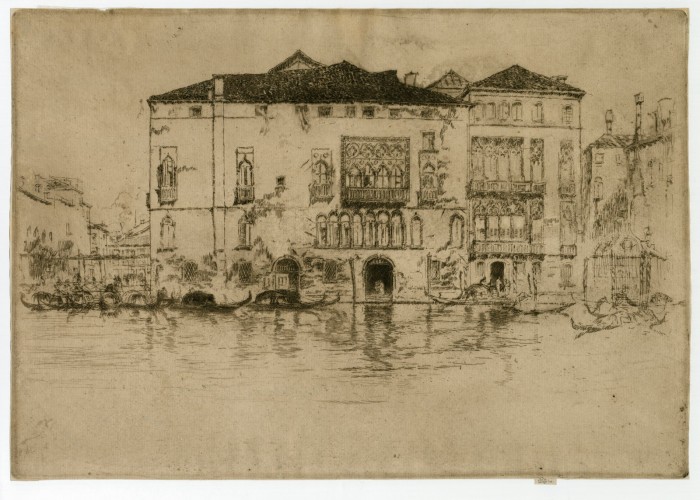The Palaces – Venice

James McNeill Whistler (1834-1903), The Palaces, 1879-80, etching on laid paper; trimmed on the platemark by the artist, signed with the butterfly and inscribed imp on the tab. Reference: Kennedy 187, third (final) state; Lochnan 184.
Provenance: P. & D. Colnaghi & Co., London (their stock no. in pencil verso C.13455)
Kennedy Galleries, New York (their stock no., partially erased, in pencil verso a 66798)
Thérèse Lowndes Noble, New York (Lugt 1953 but not stamped; according to a note on the mat of the previous owner)
private collection, USA (acquired 1979–80)
A fine impression.
The print shows on the verso three tiny circles in pencil, a sign that has often been interpreted as Whistler’s method of marking a choice impression. However, as Ruth Fine has pointed out, “no document […] has been located which verifies this. […] If these annotations were a Whistlerian designation of quality, they were probably one more aspect of the artist’s public relations campaign, allowing certain buyers to think they were getting something extraordinary”.
The Palaces is Whistler’s largest etching, depicting the Sagredo and Pesaro palaces at Santa Sofia. Both of them “are Gothic, a period Whistler otherwise largely avoided in Venice”. Compositionally one may position it at an interesting transition point. In most of the other architectural views from the First Venice Set Whistler continues to use his characteristic framing devices, usually with some kind of passageway that pulls the viewer into the image (see e.g. The Lime-Burner above). Here one is confronted with the large facade of the palace, set parallel to the picture plane. The door is shaded with dense lines and does not allow any view through into a deeper layer of space. If one were to cut out the palace alone without the surrounding sky and water, the composition would already closely resemble the later Venice and Amsterdam facades. Steps and The Embroidered Curtain show this artistic development in the present catalogue at its most accomplished level.
Published as part of the First Venice Set in 1881.